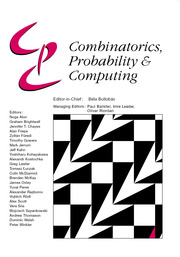Crossref Citations
This article has been cited by the following publications. This list is generated based on data provided by Crossref.
Häggkvist, Roland
and
Thomason, Andrew
1995.
Oriented hamilton cycles in digraphs.
Journal of Graph Theory,
Vol. 19,
Issue. 4,
p.
471.
Bang-Jensen, Jørgen
and
Gutin, Gregory
1997.
Paths and cycles in extended and decomposable digraphs.
Discrete Mathematics,
Vol. 164,
Issue. 1-3,
p.
5.
KELLY, LUKE
KÜHN, DANIELA
and
OSTHUS, DERYK
2008.
A Dirac-Type Result on Hamilton Cycles in Oriented Graphs.
Combinatorics, Probability and Computing,
Vol. 17,
Issue. 5,
p.
689.
Keevash, Peter
and
Sudakov, Benny
2009.
Triangle packings and 1-factors in oriented graphs.
Journal of Combinatorial Theory, Series B,
Vol. 99,
Issue. 4,
p.
709.
Kühn, Daniela
Osthus, Deryk
and
Treglown, Andrew
2010.
Hamiltonian degree sequences in digraphs.
Journal of Combinatorial Theory, Series B,
Vol. 100,
Issue. 4,
p.
367.
Christofides, Demetres
Keevash, Peter
Kühn, Daniela
and
Osthus, Deryk
2010.
A Semiexact Degree Condition for Hamilton Cycles in Digraphs.
SIAM Journal on Discrete Mathematics,
Vol. 24,
Issue. 3,
p.
709.
Kühn, Daniela
and
Osthus, Deryk
2012.
A survey on Hamilton cycles in directed graphs.
European Journal of Combinatorics,
Vol. 33,
Issue. 5,
p.
750.
Treglown, Andrew
2012.
A note on some embedding problems for oriented graphs.
Journal of Graph Theory,
Vol. 69,
Issue. 3,
p.
330.
Kühn, Daniela
and
Osthus, Deryk
2013.
Hamilton decompositions of regular expanders: A proof of Kelly’s conjecture for large tournaments.
Advances in Mathematics,
Vol. 237,
Issue. ,
p.
62.
Reid, K
2013.
Handbook of Graph Theory, Second Edition.
Vol. 20134658,
Issue. ,
p.
196.
Ferber, Asaf
Krivelevich, Michael
and
Sudakov, Benny
2017.
Counting and packing Hamilton cycles in dense graphs and oriented graphs.
Journal of Combinatorial Theory, Series B,
Vol. 122,
Issue. ,
p.
196.
Sudakov, Benny
2017.
Surveys in Combinatorics 2017.
p.
372.
Bang-Jensen, Jørgen
and
Havet, Frédéric
2018.
Classes of Directed Graphs.
p.
35.
Ferber, Asaf
Long, Eoin
and
Sudakov, Benny
2018.
Counting Hamilton Decompositions of Oriented Graphs.
International Mathematics Research Notices,
Vol. 2018,
Issue. 22,
p.
6908.
Liebenau, Anita
and
Pehova, Yanitsa
2020.
An approximate version of Jackson’s conjecture.
Combinatorics, Probability and Computing,
Vol. 29,
Issue. 6,
p.
886.
Draganić, Nemanja
Correia, David Munhá
and
Sudakov, Benny
2021.
Extended Abstracts EuroComb 2021.
Vol. 14,
Issue. ,
p.
521.
Grzesik, Andrzej
and
Volec, Jan
2023.
Degree Conditions Forcing Directed Cycles.
International Mathematics Research Notices,
Vol. 2023,
Issue. 11,
p.
9711.
Draganić, Nemanja
Munhá Correia, David
and
Sudakov, Benny
2023.
Tight bounds for powers of Hamilton cycles in tournaments.
Journal of Combinatorial Theory, Series B,
Vol. 158,
Issue. ,
p.
305.
Klimošová, Tereza
and
Stein, Maya
2023.
Antipaths in oriented graphs.
Discrete Mathematics,
Vol. 346,
Issue. 9,
p.
113515.
Wang, Zhilan
Yan, Jin
and
Zhang, Jie
2024.
Cycle‐factors in oriented graphs.
Journal of Graph Theory,
Vol. 106,
Issue. 4,
p.
947.

